Planar Dragons Part I: Evil Aligned Dragons from Across the Planes
With the release of Fizban’s Treasury of Dragons last week, I thought we would take a break from our series on the different giant types to examine the dragons from previous editions that did not appear within the new book. To my surprise, there are still a TON of dragons that haven’t made their way to 5th Edition. Enough for several articles in fact. So, over the next few weeks we are going to dive into and stat up around 20 different types of dragons for your games. Considering that in Fifth Edition there are four stages of growth for each dragon, we are talking nearly 80 statblocks. So expect these next couple articles to be light on text and heavy on stats.
I thought for a while about how to best organize these articles so that they were each approximately the same length. There are a bunch of dragons specific to different planes of existence, which I think is pretty cool, and beyond the gem dragons the new book didn’t explore them much. With that in mind, here is the split I decided on:
Planar Dragons Part I: Evil Aligned
Planar Dragons Part II: Good, Neutral, and Unaligned
Chromatic and Metallic Dragons of the Material Plane
I promised to be light on text so let’s dive right in! Presented in alphabetical order:
Blight Dragons
Native Plane: The Shadowfell
Alignment: Any Evil Alignment
Description: Averagely shaped draconic bodies with rusty red scales and a webbed spine. A cloud of dust always seems to swirl around them.
Key Traits: Evil dragons that despise all things related to light and life. They delight in destruction and desolation.
Blight dragons embody the dark, lifeless nature of the Shadowfell. Their very presence causes plants and creatures alike to wither away and die, all while sustaining the dragon. The planar system is very fortunate that blight dragons are rarely found outside the shadowfell; if a blight dragon were ever to make its way onto the material plane they would wreak untold destruction. In addition to their breath weapon (necrotic damage) they can also kick up dust storms to blind their foes.
Lair Actions
On initiative count 20 (losing initiative ties), the dragon takes a lair action to cause one of the following effects; the dragon can’t use the same effect two rounds in a row:
Grasping tendrils of necrotic energy erupt in a 20-foot radius centered on a point on the ground that the dragon can see within 120 feet of it. That area becomes difficult terrain, and each creature there must succeed on a DC 15 Strength saving throw or be restrained. A creature can be freed if it or another creature takes an action to make a DC 15 Strength check and succeeds. The energy fades when the dragon uses this lair action again or when the dragon dies.
The necrotic energy within the lair consolidates around one creature the dragon can see within 60 feet of it. The target must make a DC 15 Constitution saving throw. It takes 7d8+30 necrotic damage on a failed save, or half as much damage on a successful one.
Negative energy swirls and fills a 30 foot radius sphere originating from a point the dragon can see within 120 feet. Any creature in that area can't regain hit points. Any humanoid that dies there becomes a zombie under the dragon's command. The dead humanoid retains its place in the initiative order and animates at the start of its next turn, provided that its body hasn't been completely destroyed.The area lasts until the dragon uses this lair action again or when the dragon dies.
Regional Effects
The region containing a legendary blight dragon’s lair is warped by the dragon’s magic, which creates one or more of the following effects:
Nothing can grow within 1 mile of the dragon's lair
Within 1 mile of its lair, the dragon leaves no physical evidence of its passage unless it wishes to. Tracking it there is impossible except by magical means.
The dragon can sense the life force of any creature larger than a small rodent within one mile of it's lair, provided the dragon is also within one mile of its lair.
If the dragon dies the effects fade after 1d10 days.



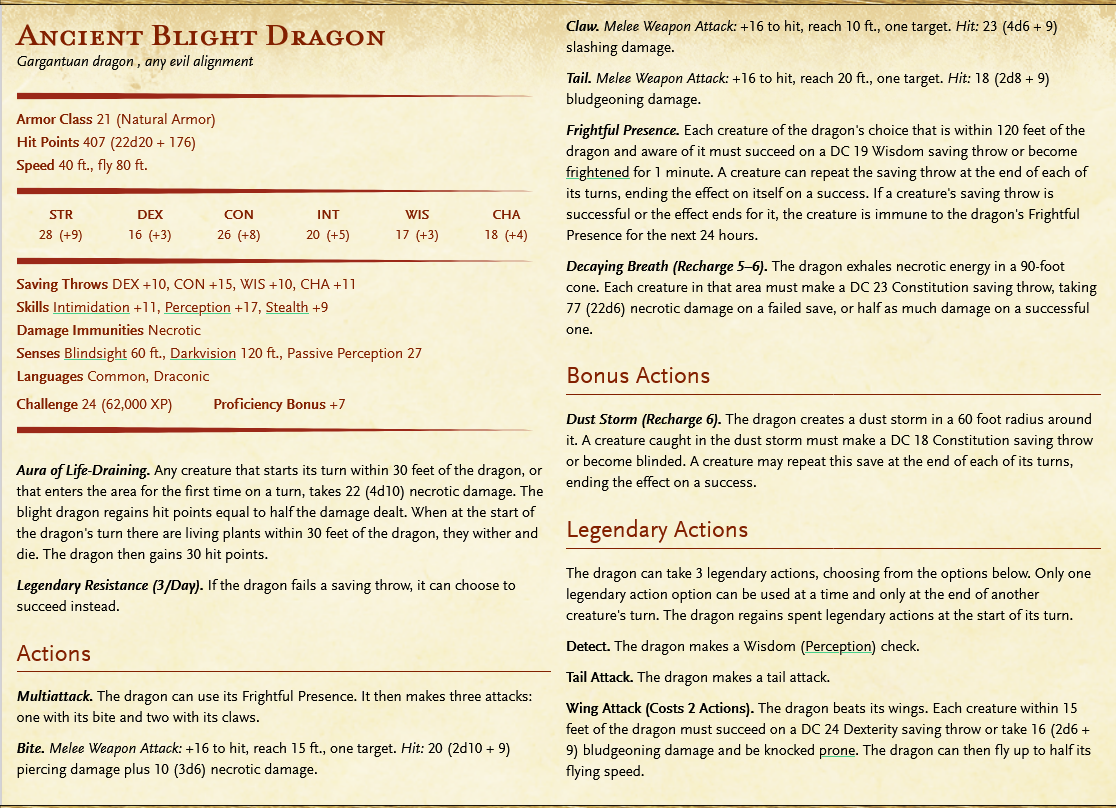
Hellfire Wyrm
Native Plane: The Nine Hells of Baator
Alignment: Lawful Evil
Description: Slender draconic bodies with bones jutting from their skulls and long, bony spines down their back. Their scales shift and shimmer, creating the illusion of flowing lava. They smell of brimstone and smoke rises off of their scales.
Key Traits: Despite their formidable combat prowess, hellfire wyrms are often used for subtle tasks like manipulation and corruption while shapeshifted.
Unlike the rest of the dragons we are looking at, the hellfire wyrms have not historically been presented in different age groups. Instead, they are assumed to be fully grown and mature dragons. So, we are going to do the same here. Hellfire wyrms have a number of potent combat abilities, including a breath weapon that ignores fire resistance, a damaging heat aura, and summoning abilities. But where you’ll most likely insert a hellfire wyrm into your world is in the royal courts and palaces of influential mortals. They serve their diabolical masters in the Hells by corrupting mortals and manipulating the events on the material plane. These wyrms mask their draconic identities and use their skills and abilities to accumulate political influence. They use this influence to start wars, slow the holy endeavors of the devout, and push mortals into corrupting their souls. Due to their similarity with red dragons, I did not write a set of lair actions/effects for hellfire wyrms. Instead, use the red dragon lair actions/effects but change any fire damage to hellfire and include rifts to the Nine Hells instead of the Elemental Plane of Fire.
Howling Dragons
Native Plane: The Windswept Depths of Pandemonium
Alignment: Chaotic Neutral/Evil
Description: Long slender bodies with dark purple scales. Thin legs and wings, with frill-like spins along their head and neck.
Key Traits: Terribly intelligent, but insane. These dragons are vicious and aggressive.
Howling dragons are not too dissimilar from a mad scientist; while their methods and behavior are insane, they are extremely intelligent and create detailed schemes within their insanity. When found on the material plane, they tend to claim isolated lairs deep within the Underdark. They can eat almost any creature, including the undead and constructs, and are ferocious hunters. Their breath weapons and innate spell abilities are focused on disabling and disorienting their foes. Howling Dragons make their lairs within the plane of madness, Pandemonium, or deep within the Underdark if they find themselves on the material plane. These lairs are within deep caverns riddled with tunnels carved by howling winds. It is cold, noisy, and dark, with no natural light. Even on the material plane, within a howling dragon's lair one can hear the tortured cries on the winds of Pandemonium.
Lair Actions
On initiative count 20 (losing initiative ties), the dragon takes a lair action to cause one of the following effects; the dragon can’t use the same effect two rounds in a row:
Psychic energy fills the air from a point the dragon can see within 120 feet of it, creating a 20-foot radius sphere of energy. Each creature in the area must make a DC 15 Intelligence saving throw, taking 21 (6d6) psychic damage on a failed save, or half as much damage on a successful one.
Mad winds fill the air, testing the mental fortitude of those nearby. Each creature within 120 feet of the howling dragon that is not native to Pandemonium must make a DC 15 Wisdom saving throw. On a failed save, the creature gains one level of exhaustion.
Shrieks of madness assault the minds of intruders. Each creature within 30 feet of the howling dragon that is not native to Pandemonium must make a DC 12 Wisdom saving throw. On a failed save, the creature suffers a form of short-term madness.
Regional Effects
The region containing a legendary red dragon’s lair is warped by the dragon’s magic, which creates one or more of the following effects:
Whispers can be heard on the wind within 6 miles of the dragon’s lair.
Wind extinguishes nonmagical open flames, such as torches or campfires, within 1 mile of the dragon's lair.
Shimmering fissures in reality within 1 mile of the dragon’s lair form portals to the plane of Pandemonium, allowing native creatures of that plane to dwell nearby.
If the dragon dies, these effects fade over the course of 1d10 days.
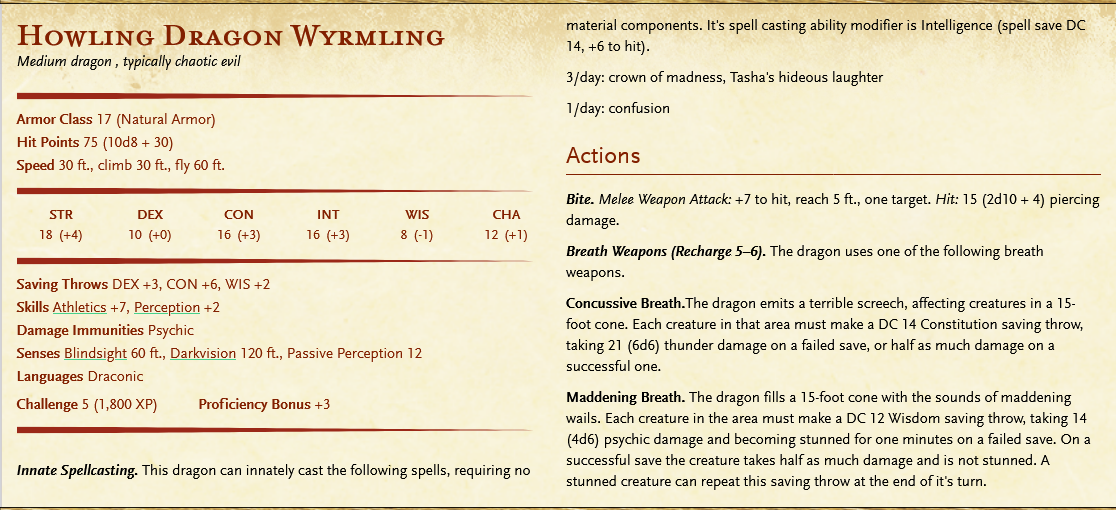
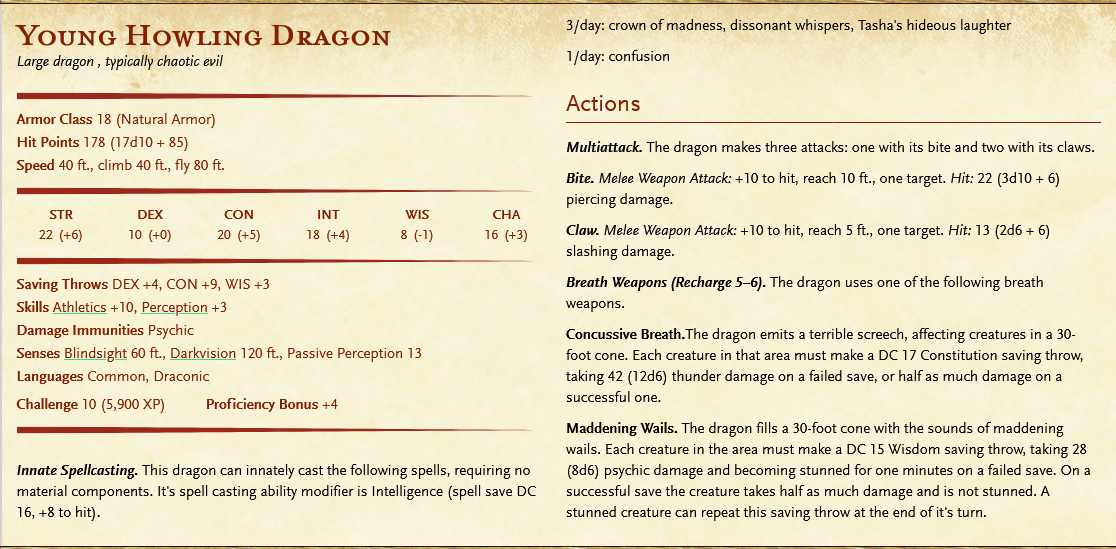
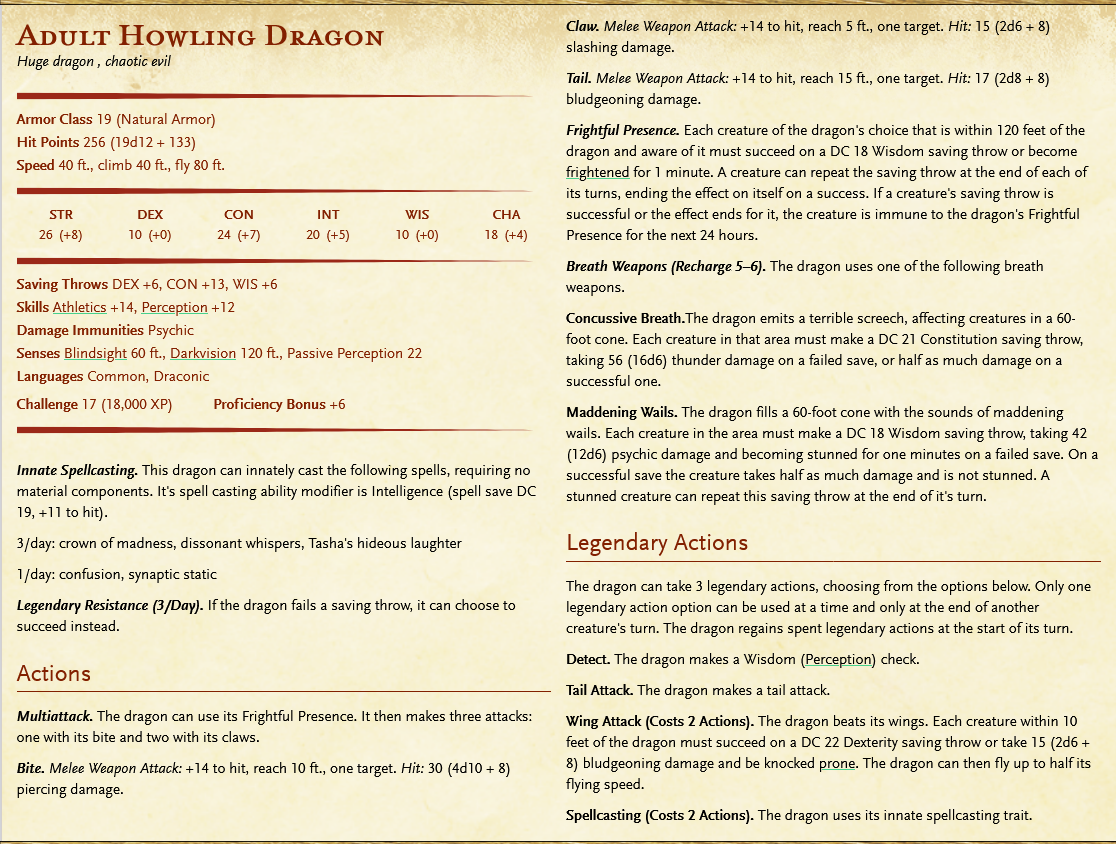
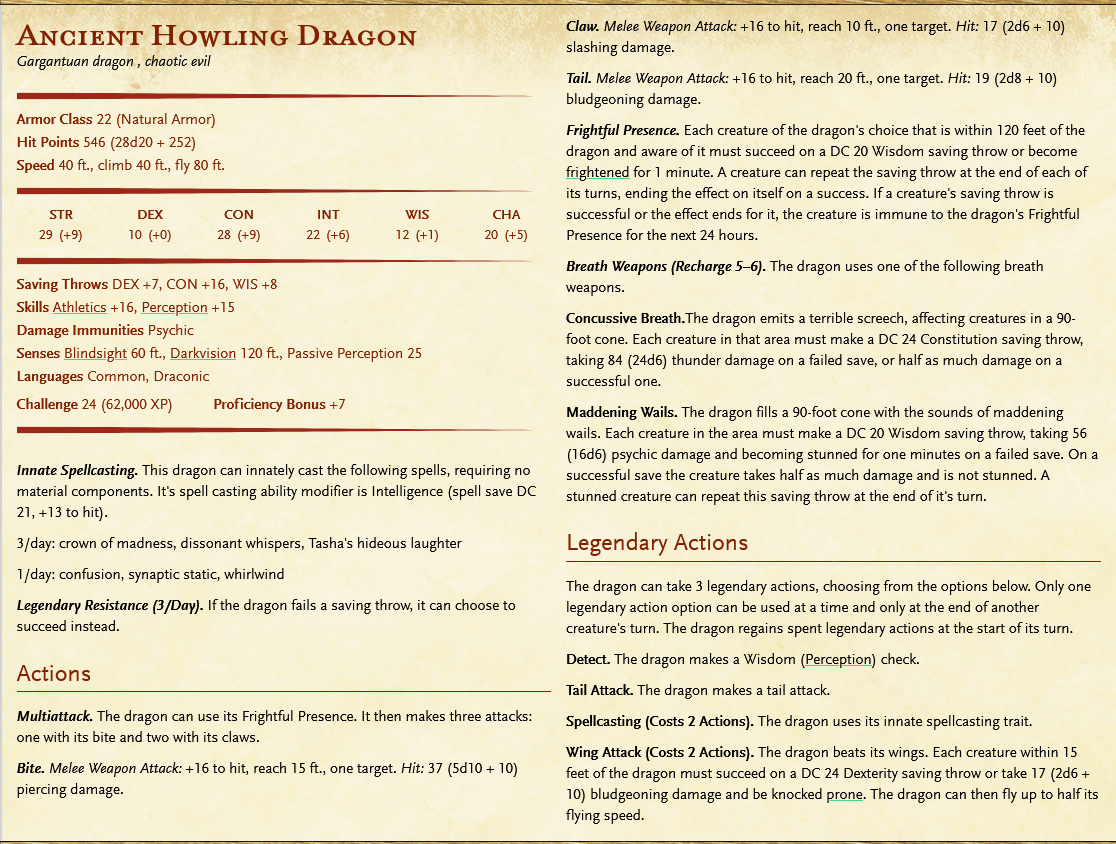
Pyroclastic Dragons
Native Plane: The Bleak Eternity of Gehenna (as well as a few locations within the elemental planes)
Alignment: Lawful/Neutral Evil
Description: Bodies shaped like a red dragon, muscled and stout. Its scales have the appearance of fragmented obsidian connected by veins of lava.
Key Traits: Quick to anger and not afraid of a fight, although they don’t necessarily go looking for trouble. To them, meat is a welcome delicacy but they can survive off of minerals.
According to the Dungeon Master’s Guide, “Gehenna is the plane of suspicion and greed. It is the birthplace of the yugoloths, which dwell here in great numbers. A volcanic mountain dominates each of the four layers of Gehenna, and lesser volcanic earthbergs drift in the air and smash into the greater mountains.” From this we can infer that the pyroclastic dragons are just as greedy and self-interested as those in the material plane. They will make their homes in the volcanic region of the plane, where it sounds like they will face heavy competition. These dragons are likely to be few and far between. If an adult or ancient pyroclastic dragon is confronted in its lair, use the red dragon’s lair actions.
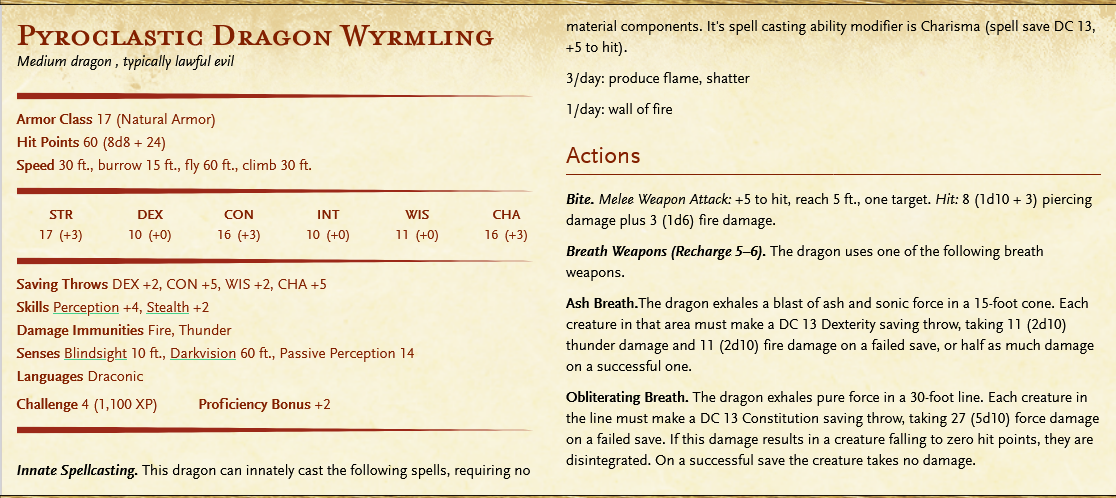
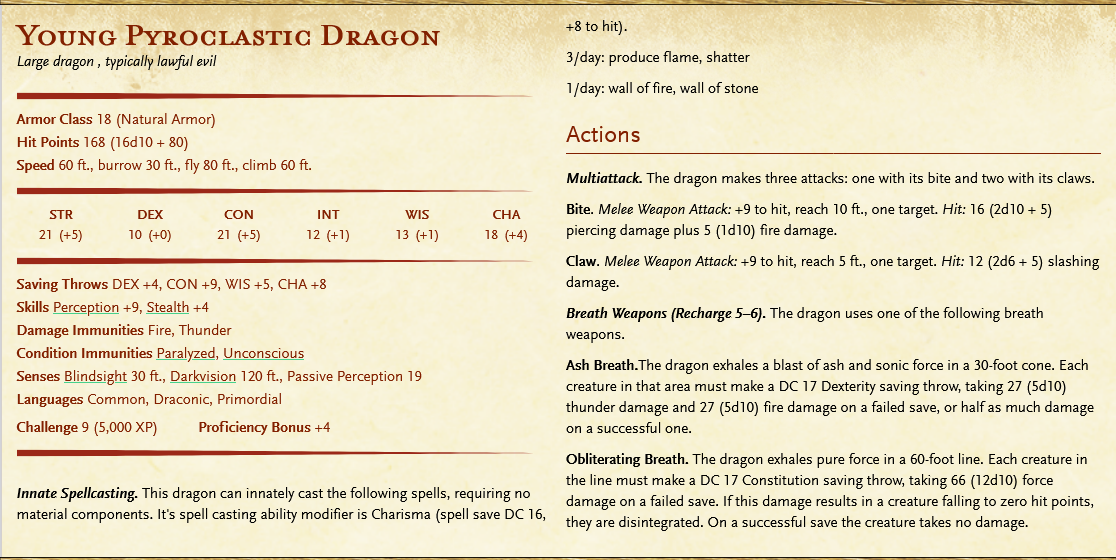
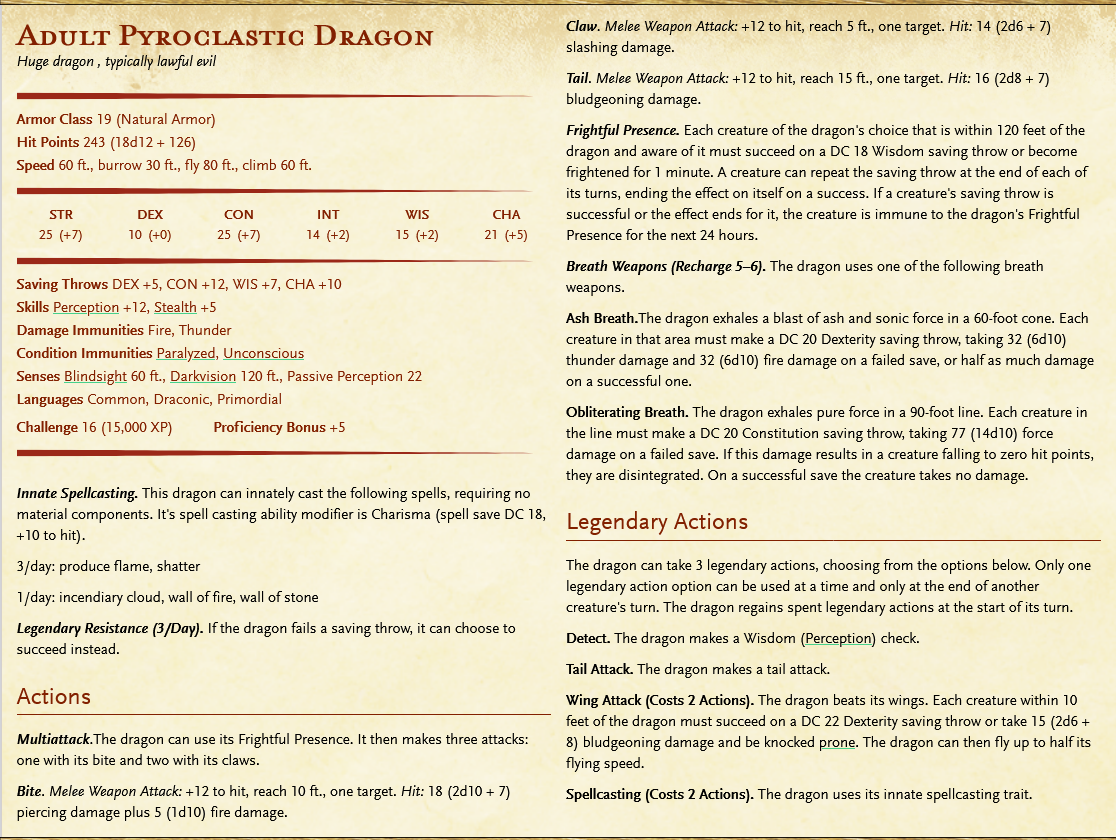

Rust Dragons
Native Plane: The Infinite Battlefield of Acheron
Alignment: Lawful Neutral/Evil
Description: Reminiscent of the metallic dragons of the material plane, but seemingly covered by oxidized metals with thin, iridescent wings. They looked somewhat insectoid, with an exoskeleton, an antennae, and somewhat butterfly shaped wings.
Key Traits: Not particularly aggressive or violent (leaning into the partially neutral nature of the plane), hunting only to feed themselves. While they do eat meat, they prefer adamantine, gold, metal, iron, silver, and steel.
Rust dragons are most commonly found on the Infinite Battlefield of Acheron, where they feast on the weapons and armor of the fallen. On the material plane, they seek out underground caverns with access to veins of ore. These dragons are exceptionally difficult for humanoid groups and settlements to deal with, as their bites and breath weapons rust even the most finely crafted weapons and armor.
Lair Actions
On initiative count 20 (losing initiative ties), the dragon takes a lair action to cause one of the following effects; the dragon can’t use the same effect two rounds in a row:
Jagged bits of rusted metal fill a 20-foot-radius sphere centered on a point the dragon can see within 120 feet of it. The cloud spreads around corners, and its area is heavily obscured. Each creature in the cloud when it appears must make a DC 10 Dexterity saving throw, taking 10 (3d6) piercing damage on a failed save, or half as much damage on a successful one. A creature that ends its turn in the cloud takes 10 (3d6) piercing damage. A wind of at least 20 miles per hour disperses the cloud. The cloud otherwise lasts until the dragon uses this lair action again or until the dragon dies.
Spears of rusted metal burst through the ground, striking up to three creatures that the dragon can see within 120 feet of it. The dragon makes one ranged attack roll (+7 to hit) against each target. On a hit, the target takes 14 (4d6) piercing damage.
The dragon creates an opaque wall of rusted metal on a solid surface it can see within 120 feet of it. The wall can be up to 30 feet long, 30 feet high, and 1 foot thick. When the wall appears, each creature within its area is pushed 5 feet out of the wall's space; appearing on whichever side of the wall it wants. Each 10-foot section of the wall has AC 10, 30 hit points, and immunity to acid, cold, necrotic, poison, and psychic damage. The wall disappears when the dragon uses this lair action again or when the dragon dies.
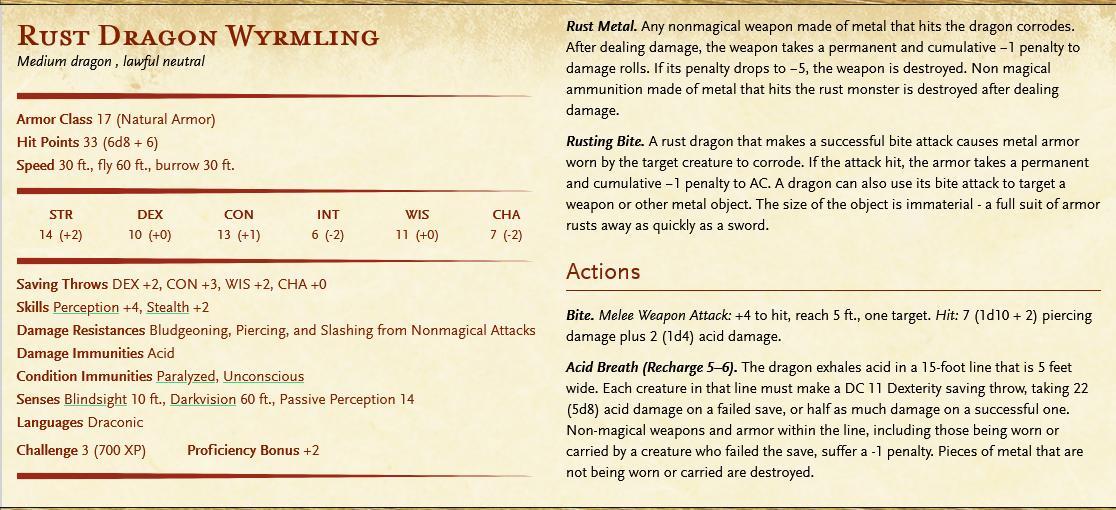
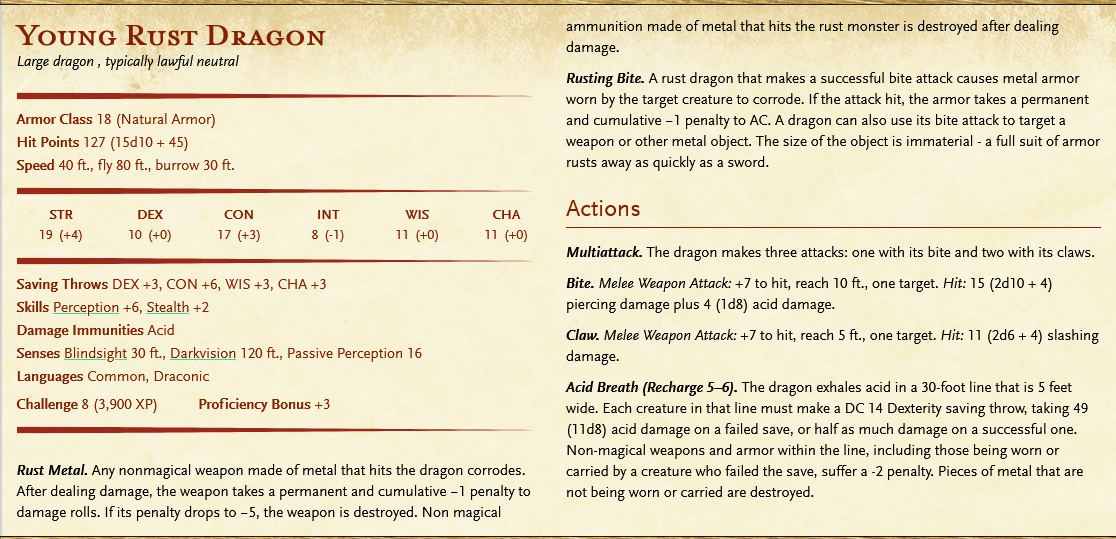
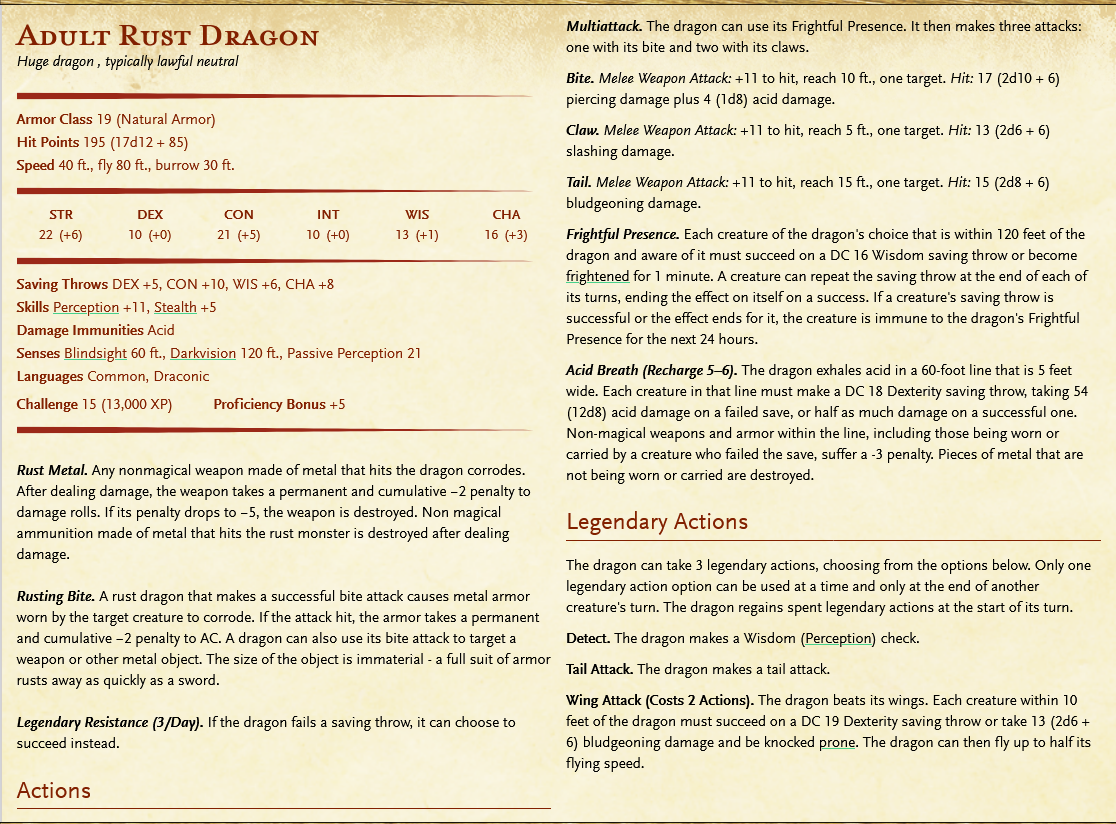
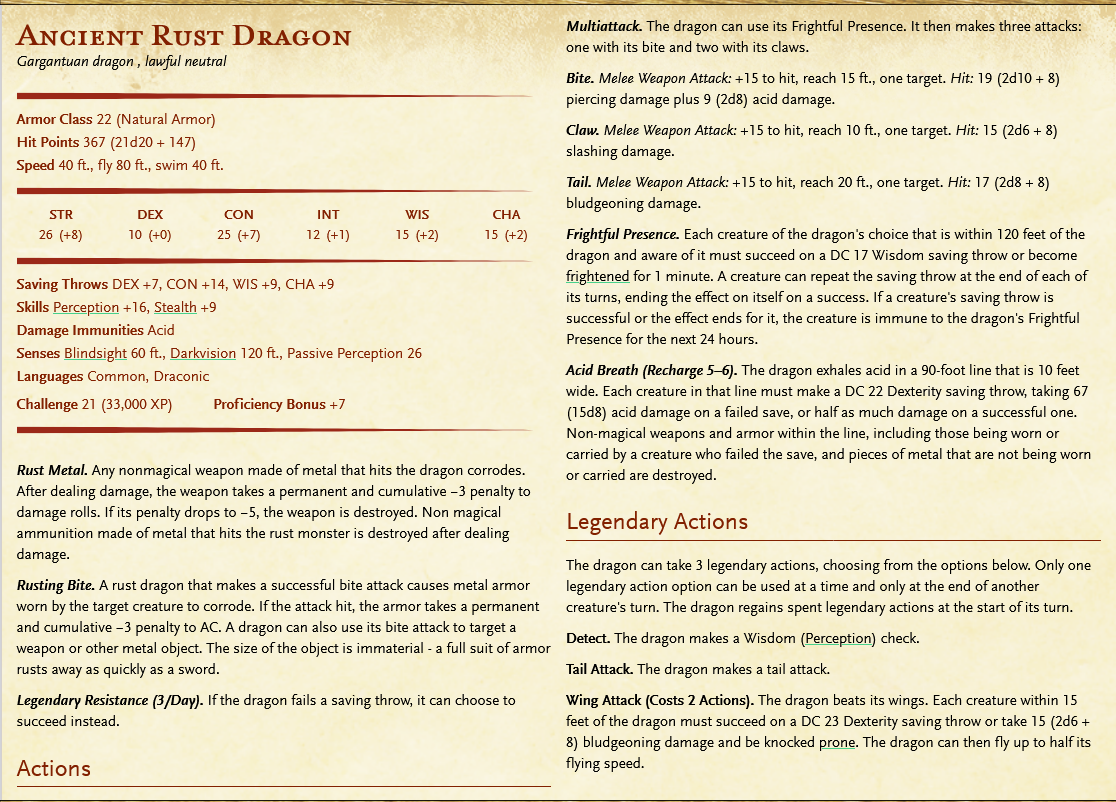
Styx Dragons
Native Plane: The first layer of all the lower planes where the River Styx flows; The Abyss, the Nine Hells, Pandemonium, Carceri, Hades, Gehenna, Ancheron
Alignment: Neutral Evil
Description: Long and serpentine bodies with slimey brown scales. They have small, fin-like wings.
Key Traits: They live and thrive underwater and are incapable of flight, although they can survive on land. They don’t have claws or wings like a typical dragon, although they do have sharp, bladed tails in addition to their bite and breath weapons.
In a departure from the norm, Styx dragons are incapable of flight. Their limbs are small and ineffective and their wings act more like a fish’s fins. However, they are among the most dangerous underwater foes one could come across. They make their lairs within the muddy banks of the River Styx, or in the rare case they are brought to the material plane, the putrid, stagnant waters of large swamps. Their primary prey are the fiendish inhabitants of the lower planes, though they will eat almost any living thing they can catch. They are not schemers or manipulators.
Lair Actions
On initiative count 20 (losing initiative ties), the dragon takes a lair action to cause one of the following effects; the dragon can’t use the same effect two rounds in a row:
Pools of water that the dragon can see within 120 feet of it surge outward in a grasping tide. Any creature on the ground within 20 feet of such a pool must succeed on a DC 15 Strength saving throw or be pulled up to 20 feet into the water and knocked prone.
A cloud of yellow, nauseating gas fills a 20-foot-radius sphere centered on a point the dragon chooses within 120 feet of it. The cloud spreads around corners, and its area is heavily obscured. The cloud lingers in the air for the duration. Each creature that is completely within the cloud at the start of its turn must make a DC 15 Constitution saving throw against poison. On a failed save, the creature spends its action that turn retching and reeling. Creatures that don't need to breathe or are immune to poison automatically succeed on this saving throw.
The dragon summons forth a giant crocodile from the foul waters. This creature uses the giant crocodile statblock, but has the fiend type.
Regional Effects
The region containing a legendary Styx dragon’s lair is warped by the dragon’s magic, which creates one or more of the following effects:
Within 1 mile of the lair, creatures have trouble remembering minor events from their past, such as their date of birth.
Water sources within 1 mile of the lair are supernaturally fouled. Enemies of the dragon that drink such water regurgitate it within minutes.
Fog lightly obscures the land within 6 miles of the lair.
If the dragon dies, the water remains fouled, but other effects fade over 1d10 days.
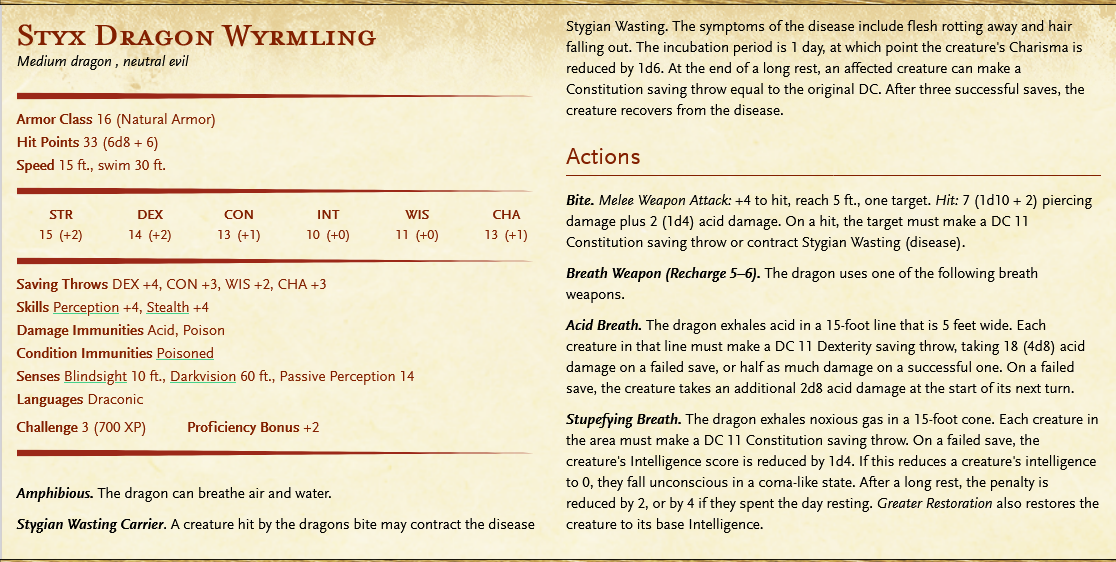
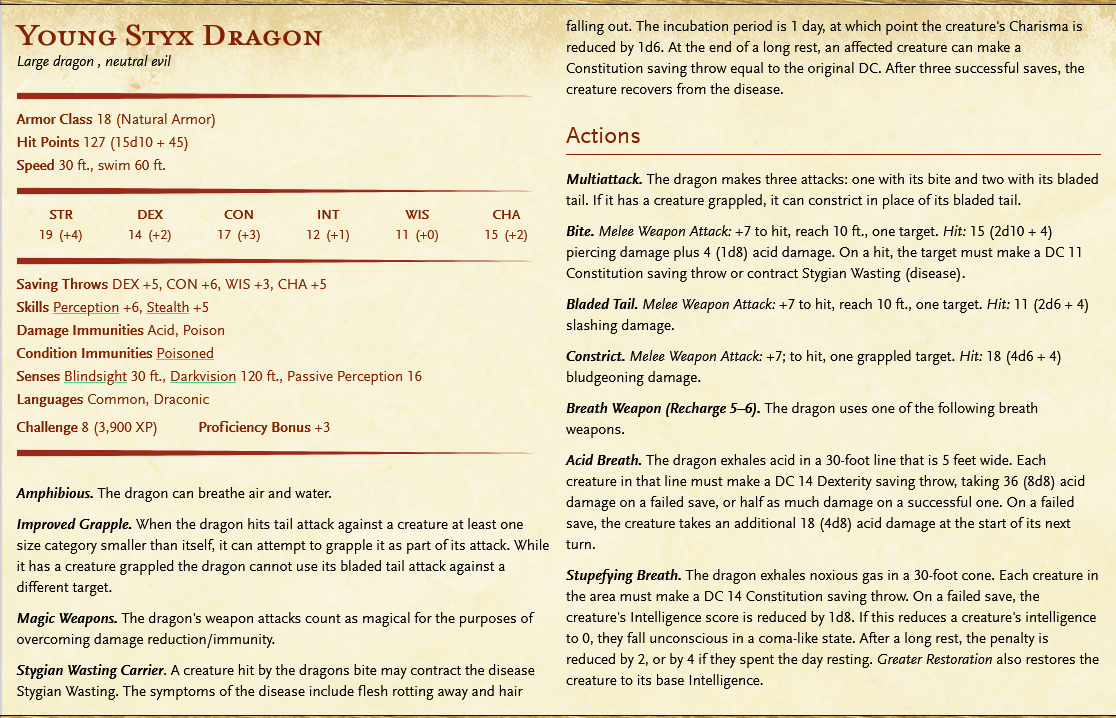


Tarterian Dragons
Native Plane: The Tarterian Depths of Carceri
Alignment: Neutral/Chaotic Evil
Description: Malnourished gray and green dragons with tattered wings and black claws/teeth. They always seem to be grinning.
Key Traits: Tarterian dragons are extremely mobile themselves and have many ways to restrict the movement of their foes, preferring to fight them one at a time. They fight due to hunger; while they will prey on any creature they believe to be weaker than themselves, their preferred diet is one of fiends and condemned souls.
Tarterian dragons are both wardens and prisoners on the prison plane of Carceri. They are not resentful of this imprisonment, in fact if they find their way to the material plane they will attempt to replicate that environment. A Tarterian dragon likes to start combat by weakening its enemies with its Disheartening Breath and then using one of its spells to separate those who succeeded the save, taking out the weakest enemies first. They use their speed and mobility to their full advantage, skirting in and out of melee combat.
Lair Actions
On initiative count 20 (losing initiative ties), the dragon takes a lair action to cause one of the following effects; the dragon can’t use the same effect two rounds in a row:
Chains and shackles shoot out from the ground in a 20-foot radius centered on a point the dragon can see within 120 feet of it. Each creature other than the dragon on the ground in that area must succeed on a DC 15 Dexterity saving throw or be restrained by the chains. A creature can use its actions to attempt to break free with a DC 15 Strength (Athletics) or Dexterity (Acrobatics) check.
A tremor shakes the lair in a 60-foot radius around the dragon. Each creature other than the dragon on the ground in that area must succeed on a DC 15 Dexterity saving throw or be knocked prone.
Gases form a cloud in a 20-foot-radius sphere centered on a point the dragon can see within 120 feet of it. The sphere spreads around corners, and its area is lightly obscured. It lasts until initiative count 20 on the next round. Each creature that starts its turn in the cloud must succeed on a DC 13 Constitution saving throw or be poisoned until the end of its turn. While poisoned in this way, a creature is incapacitated.
Regional Effects
The region containing a legendary red dragon’s lair is warped by the dragon’s magic, which creates one or more of the following effects:
Small earthquakes are common within 6 miles of the dragon’s lair.
The faint sounds of suffering echo through the air within 1 mile of the dragon's lair.
Good aligned beings feel an unshakable sense of dread and unease within 1 mile of the dragon's lair.
If the dragon dies, these effects fade over the course of 1d10 days.
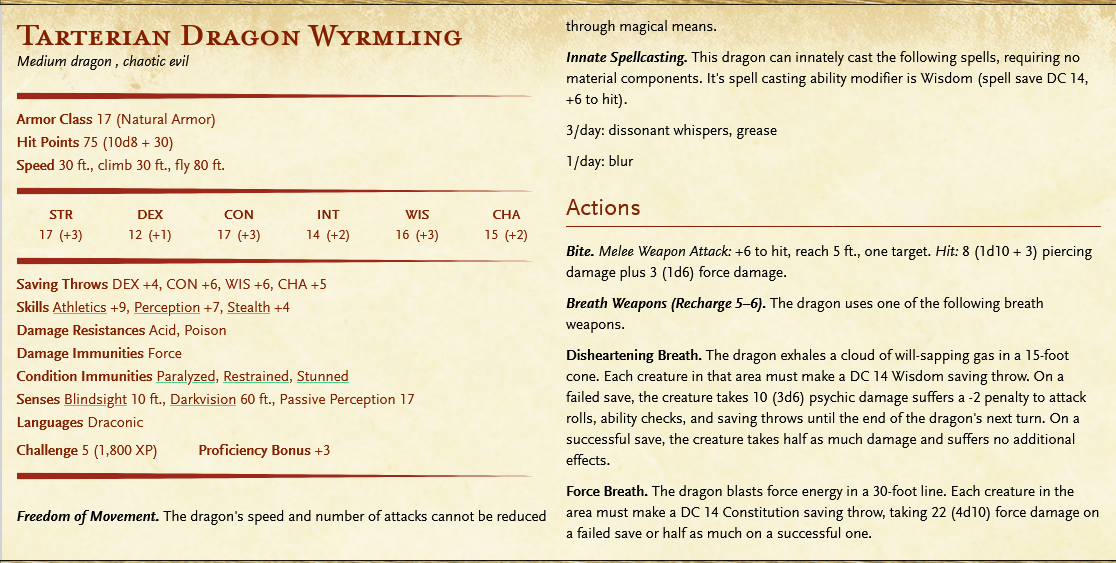
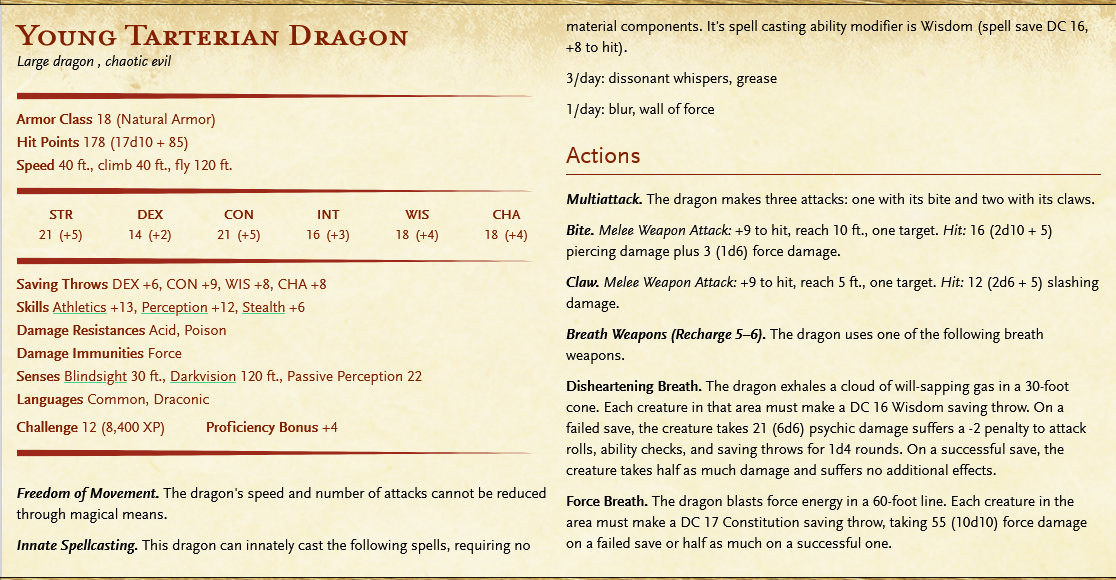
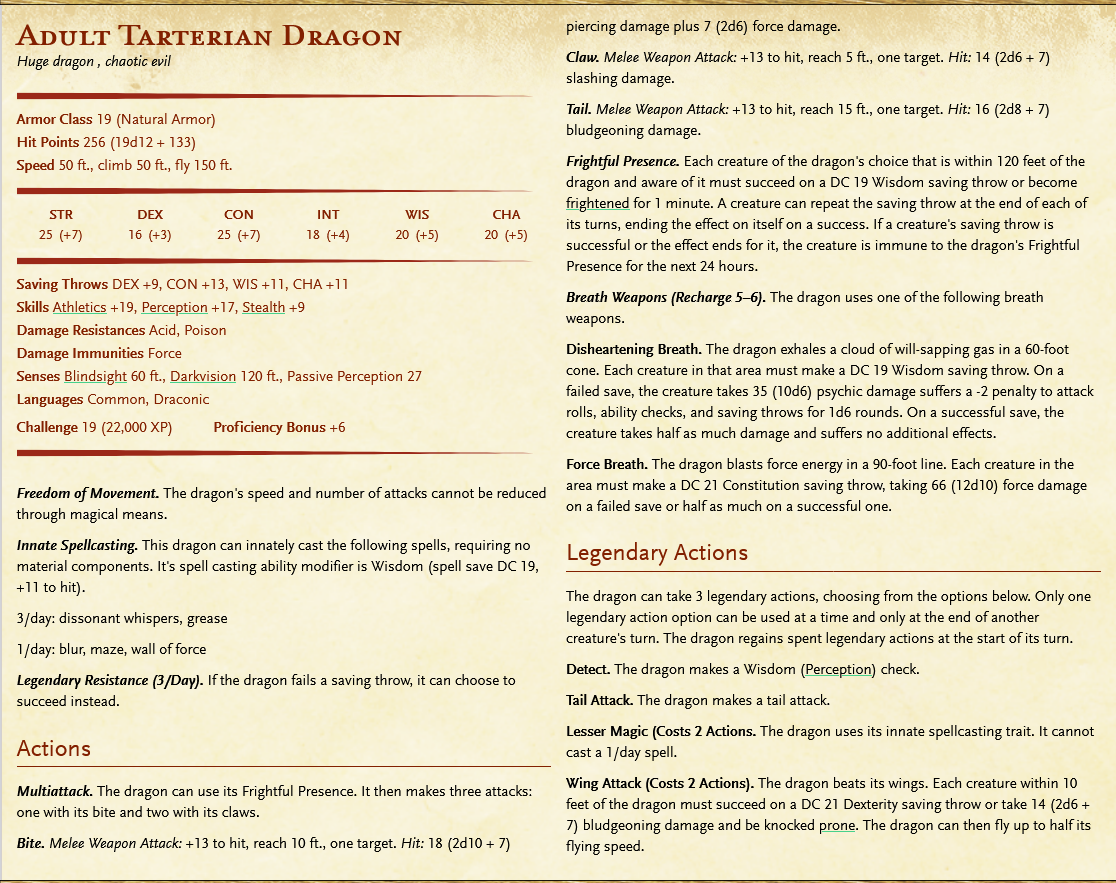
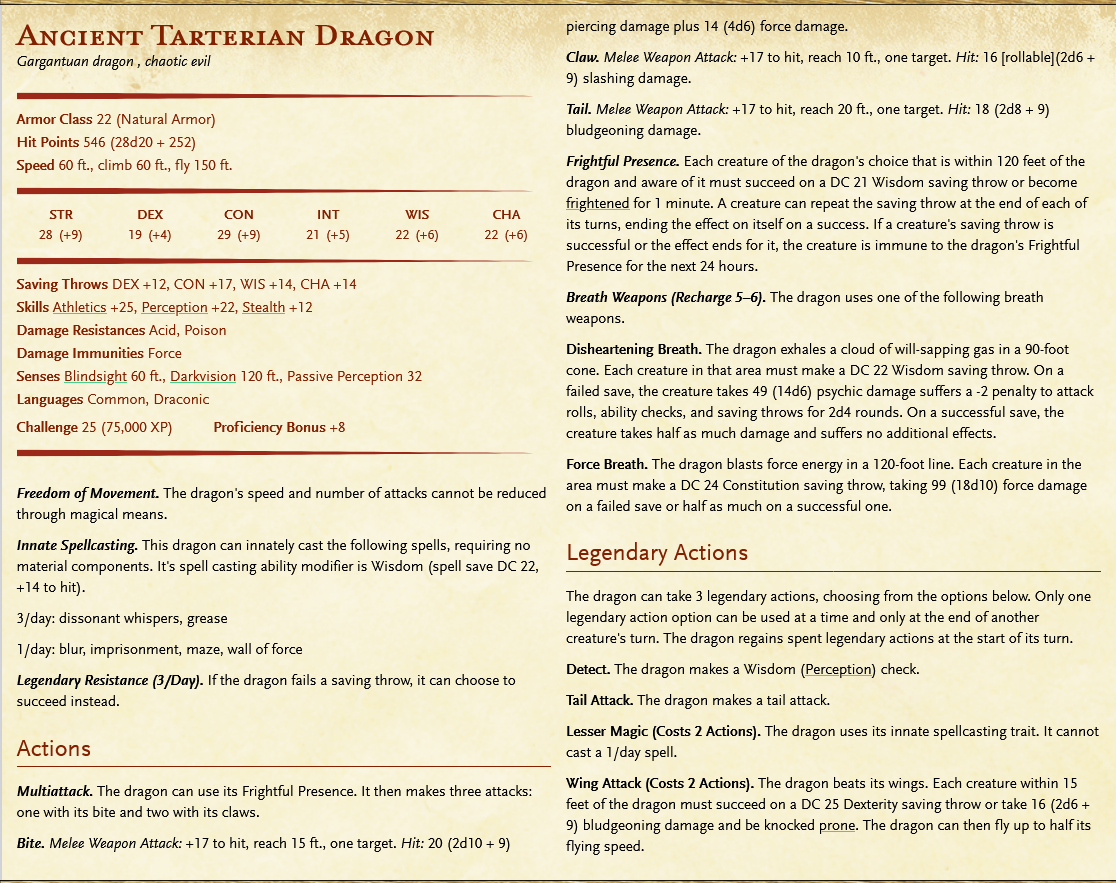
Next Week: Good and neutral aligned planar dragons for use as patrons, allies, or rivals.

